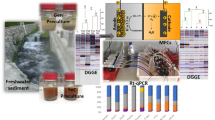Abstract
Propionate was used as fuel to enrich an electrochemically-active microbial consortium in a microbial fuel cell, and the bacterial consortium was analyzed by culture-independent methods including denaturing gradient gel electrophoresis (DGGE) of the 16S rDNA, and by fluorescent in situ hybridization (FISH). MFCs fed with propionate produced a current of 4.88 ± 0.1 mA stably on 100 mg propionate/l as COD within 3 weeks of the enrichment. When the MFCs were fed with H2-saturated fuel containing propionate, the current dropped to 3.82 ± 0.07 mA. The maximum current generated was up to 8.8 mA when MFCs were fed with 200 mg propionate/l as COD. The DGGE of 16S rDNA showed that propionate-enriched MFCs have a different bacterial population from that enriched with acetate and from the inoculum used for enrichment. The major member (42%) of the consortium was an unidentified bacterium followed by γ, β, and δ-proteobacteria.








Similar content being viewed by others
References
American Public Health Association (1995) Standard methods for the examination of water and wastewater, 19th edn. American Public Health Association, Washington, DC
Allen RM, Bennetto HP (1993) Microbial fuel cells. Appl Biochem Biotechnol 39:27–40
Chang IS, Jang JK, Kim M, Gil GC, Kim HJ, Cho BW, Kim BH (2004) Continuous determination of biochemical oxygen demand using microbial fuel cell type biosensor. Biosens Bioelectron 19:607–613
Chang IS, Moon H, Jang JK, Kim BH (2005) Improvement of microbial fuel cell performance as a BOD sensor using respiratory inhibitors. Biosens Bioelectron 20:1856–1859
Chaudhuri S, Lovley DR (2003) Electricity generation by direct oxidation of glucose in mediatorless microbial fuel cell. Nature Biotech 21:1229–1232
Gil GC, Chang IS, Kim BH, Kim M, Jang JK, Park HS, Kim HJ (2003) Operational parameters affecting the performance of a mediator-less microbial fuel cell. Biosens Bioelectron 18:327–334
Holmes DE, Bond DR, O’Neil RA, Reimers CE, Tender LR, Lovley DR (2004) Microbial associated with electrodes harvesting harvesting electricity from a variety of a aquatic sediments. Microbial Ecol 48:178–190
Jang JK, Chang IS, Moon H, Kang KH, Kim BH (2006) Nitrilotriacetic acid degradation under microbial fuel cell environment. Biotech Bioeng 95:772–774
Kim BH, Gadd GM (2008) Bacterial physiology and metabolism, 1st edn. Cambridge University Press, Cambridge, p 337
Kim BH, Ikeda T, Park HS, Kim HJ, Hyun MS, Kano K, Takagi K, Tatsumi H (1999a) Electrochemical activity of an Fe (III)-reducing bacterium, Shewanella putrefaciens IR-1, in the presence of alternative electron acceptors. Biotechnol Tech 13:475–478
Kim BH, Kim HJ, Hyun MS, Park DH (1999b) Direct electrode reaction of Fe(III) reducing bacterium, Shewanella putrefaciens. J Microbiol Biotechnol 9:127–131
Larminie J, Dicks A (2000) Fuel cell systems explained, vol 1. Wiley, West Susses, p 66
Lee J, Phung NT, Chang IS, Kim BH, Sung HC (2003) Use of acetate for enrichment of electrochemically active microbes and their 16S rDNA analyses. FEMS Microbiol Lett 223:185–191
Logan BE, Regan JM (2006) Electricity-producing bacterial communities in microbial fuel cell. Trends Micorbiol 14:512–518
Phung NT, Lee J, Kang KH, Chang IS, Gadd GM, Kim BH (2004) Analysis of microbial diversity in oligotrophic microbial fuel cell using 16S rDNA analyses. FEMS Microbiol Lett 233:77–82
Rabaey K, Verstraete W (2005) Microbial fuel cells: novel biotechnology for energy generation. Trends Biotechnol 23:291–298
Acknowledgements
This study was supported by the Korea Research Foundation Grant funded by the Korean Government” (KRF-2006-214-D00081), in which main calculations were performed by using the supercomputing resource of the Korea Institute of Science and Technology Information (KISTI). This study was also partly supported by the Korea Science and Engineering Foundation (KOSEF) NRL program grant funded by the Korea government (MEST) (No. R0A-2008-000-20088-0).
Author information
Authors and Affiliations
Corresponding author
Rights and permissions
About this article
Cite this article
Jang, J.K., Chang, I.S., Hwang, H.Y. et al. Electricity generation coupled to oxidation of propionate in a microbial fuel cell. Biotechnol Lett 32, 79–85 (2010). https://doi.org/10.1007/s10529-009-0118-y
Received:
Revised:
Accepted:
Published:
Issue Date:
DOI: https://doi.org/10.1007/s10529-009-0118-y




